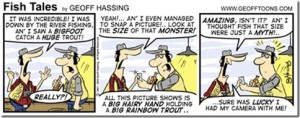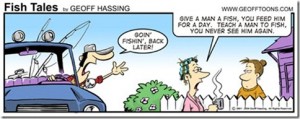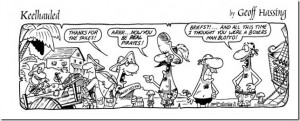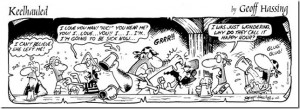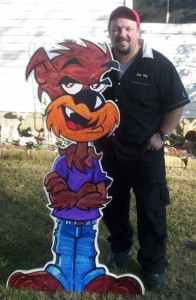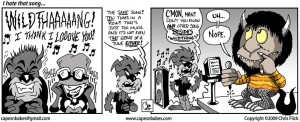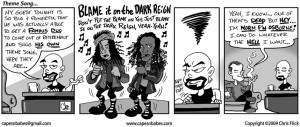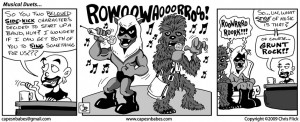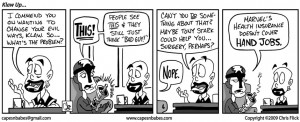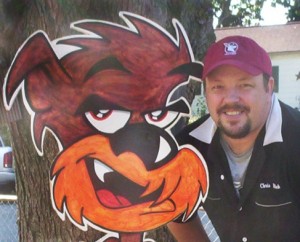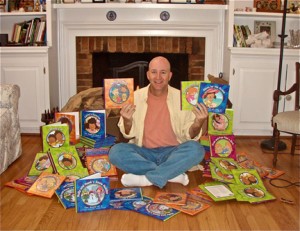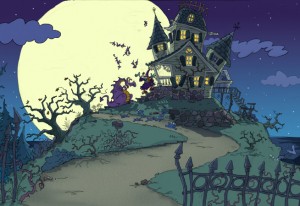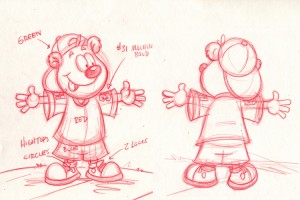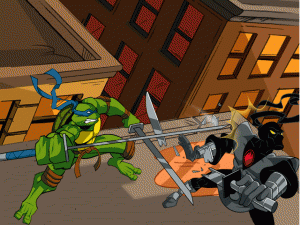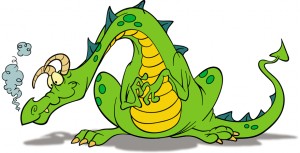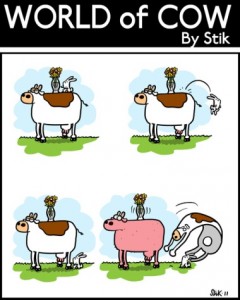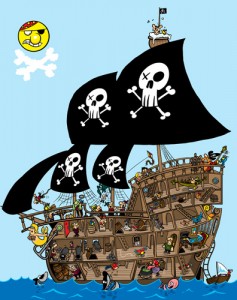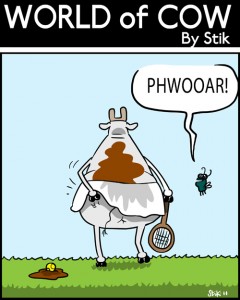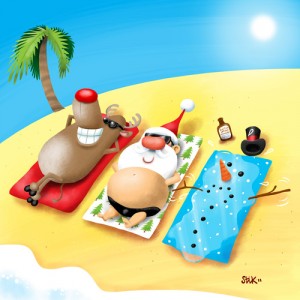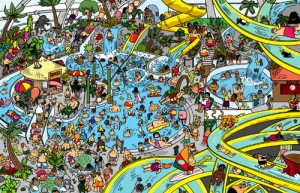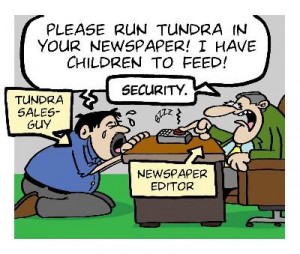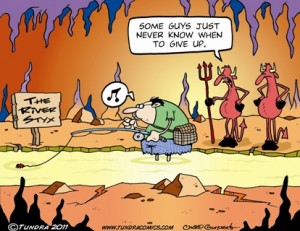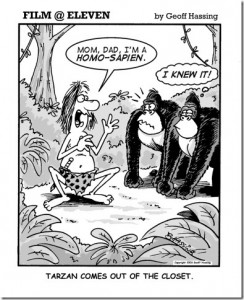 Geoff Hassing is a very humorous self taught cartoonist, who works as a freelance illustrator and children’s book illustrator. I was a little amazed when I found out he has learned everything he knows by himself. His comics “Film@eleven” and “Fish Tales” are some of the funniest I’ve read. Geoff is also a member of The National Cartoonist Society and worked on video games, toy design, and comic books to name just a few things under his creative belt.
Geoff Hassing is a very humorous self taught cartoonist, who works as a freelance illustrator and children’s book illustrator. I was a little amazed when I found out he has learned everything he knows by himself. His comics “Film@eleven” and “Fish Tales” are some of the funniest I’ve read. Geoff is also a member of The National Cartoonist Society and worked on video games, toy design, and comic books to name just a few things under his creative belt.
David: Hey Geoff, It’s great to be featuring you on “Don’t Pick the Flowers” blog. You have a great history working creatively with comics, cartoons, and video games, to name a few. When did you decide to make cartoons/comics your life work?
Geoff: Hey there Dave! Thanks for having me, it’s a real honor. Good question… I decided I was going to be a cartoonist when I was around 6 or 7 years old and I wrote Charles Schulz a letter, and sent him some drawings too… like every other kid in the world was doing back then in the early 70’s. Surprisingly, he wrote me back an encouraging letter to keep it up and keep practicing. He also sent along some photocopies of Peanuts artwork which he signed, but the most exciting thing was a real Snoopy and Woodstock sketch!! I was hooked! From that day forward, I decided I was going to be a professional cartoonist no matter what, and that’s what I’ve worked toward ever since. Unfortunately, the letter and sketch were lost in a fire back in 1992. Pretty sad, it was one of my prized possessions.
David: You have two comics you work regularly on, “Film @ Eleven” and “Fish Tales”, and I also know about your “Ninja Comics”, which I love. Do you have plans to make this into a comic strip in the future?
Geoff: I’ve had quite a few comics over the years that I’ve tried to get syndicated without luck, but yeah, Film @ Eleven and Fish Tales are my most recent. But even then, I haven’t done any new strips for them in a couple years because the last 3 years I’ve been swamped illustrating children’s books for Grape City Inc. and MeySen Academy in Japan. Unfortunately that ended back in June, so I’ve been looking for new gigs, but have worked on a few small projects since then, including an iPad game that should be out soon.
I was playing around with the Ninja comic idea, and my character “Ninja Bob, the Suburban Ninja”, but felt for a regular comic strip it would run out of material too fast to be sustainable for a long time. But I do love Ninjas! I still may do something with it sometime, maybe a webcomic.
I am working on developing a new strip right now that I feel has a lot of potential and that a lot of people could relate to it, but I can’t really say too much about it yet. I’m in the process of writing material for it and figuring out the look and feel of the strip and if it will be sustainable as well. I’ll keep you posted!
David: Can you describe some of your creative process when you are at the drawing board? What are the things that inspire you to create?
Geoff: Wow, talk about loaded questions. lol! For example, when I’m creating a Film @ Eleven cartoon, I draw a funny cartoon. Oh! … you mean more in-depth than that?.. Okay, lemme’ try that again.
Well, I suppose like most cartoonists, I take an everyday situation, like dating, work, relationships and so on, and put my own personal spin on it. Which is a lot harder than people think it is. Cartooning is very hard in the respect that you don’t know if something is funny until you put it out there, and even then, some of the cartoons that you thought were hilarious, fall flat, but the ones you thought stunk up the place are the ones that people love most. So really, you just don’t know until you put it out there in front of people.
The most important part thing is to go with your gut. If your gut tells you something is funny, it probably is. It may not appeal to everyone, but that’s okay, because you’re never going to make everyone laugh, we all have different kind of humor that appeal to us, but if you can reach the people that like the same kind of humor you have, you’ll get a loyal following that will love your cartoons and support you faithfully!
David: You are a member of the National Cartoonist’s Society, which is a great honor, with a lot of awards. What do you consider to be your greatest achievement as a cartoonist?
Geoff: I just became a member of the NCS this year, which is one of the greatest honors and achievements of my life so far. I’ve had two life-long goals as a cartoonist, the first, to have a syndicated strip, which I haven’t achieved yet, and with the current state of newspapers, I may never be able to.
The second goal was to become a member of the National Cartoonists Society. And the biggest reason for that was because my two greatest cartooning heroes, Charles Schulz and Sergio Aragones were and are members of the NCS, and I knew if I could ever become a good enough cartoonist to be accepted as a member of the NCS, I would know within my heart that I had finally become “a professional cartoonist!” And when you really think of it, there’s not a lot of people out there in the world that can say that. It’s something I’m very proud of.
As far as awards, the only cartooning award I’ve received is from Cartoonist’s Northwest, a great cartooning organization in Seattle, that voted my Film @ Eleven, Homo-sapian Tarzan cartoon the “Best of the Northwest!” for 2003. That was an exciting honor to get, and something I’m very proud of as well.
David: Besides naming a few of your cartooning hero’s, who are some of the newer cartoonist you have been paying attention to?
Geoff: Boy, another tough question. Most of my influences are a lot of the usual suspects, Charles Schulz, Sergio Aragones, Don Martin, Duck Edwing, Gary Larson, Berke Breathed, Watterson… too many to list. A lot of my influences these days are also my friends, known and unknown cartoonists, but incredibly talented nonetheless… Cartoonists like Stephan Pastis, Glenn and Gary McCoy, Rick Stromoski, Randy Mcllwaine, Bucky Jones, Paul Boscocci, Mike Drinkwater, Dave Blazek, Christine Tripp, Stephanie Piro, Dave Reddick, Drew Litton, Ed Stein, Elena Steier, Dave Coverly, Bill Alger, Mike Spicer, Bob Camp, Bob Staake… way too many to list. And I feel bad, because there are so many more I could list. I find inspiration in all of them.
David: What’s next with Geofftoons, what’s on the horizon?
Geoff: At the end of June I finished up a 3 year run illustrating children’s books, which was a lot of fun, and was bummed to have come to and end, but that’s the nature of the beast being a freelancer, even the best gigs eventually come to an end.
Right now I have a few different irons in a few different fires while I decide what direction to go next. I’d like to illustrate more children’s books, but in the commercial market. I also just completed the artwork for a small iPad game for an indie developer which should hopefully be out soon, and would love to do more gaming work in regular and casual gaming, and learn that market more since there seem to be a lot of cartooning opportunities there.
Beyond that, I haven’t given up on comics. I’m developing some ideas for a new comic strip that I feel has some potential, but we’ll have to see how it goes. Comics are still my first love and my passion, and I still haven’t completely given up on having a syndicated strip. After all, that’s the dream.
David: Sounds great Geoff, I love your work and I know so many others do too. You have a great drawing/cartooning style with hilarious humor. I can’t wait to see what is next.
Find out more of Geoff Hassing and his work at: www.geofftoons.com

